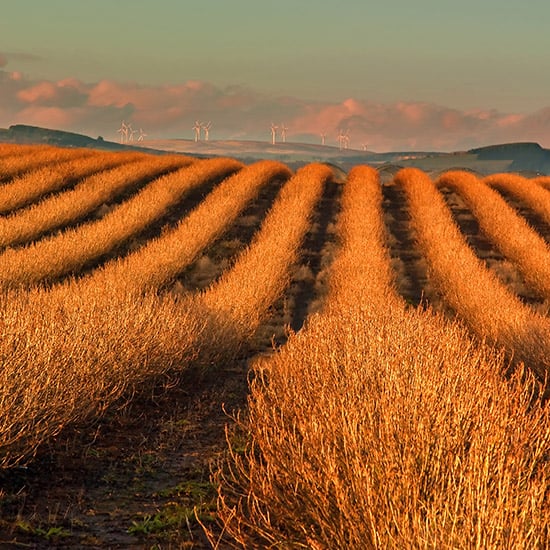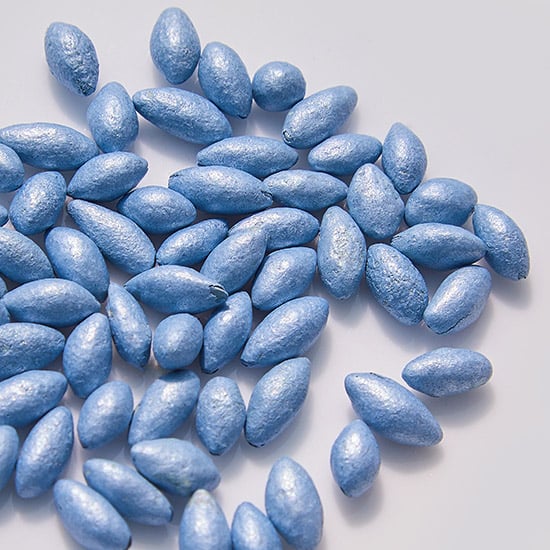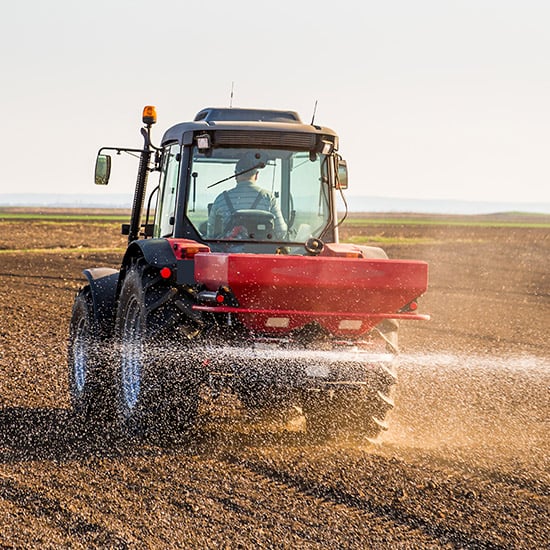
A field of raspberries, a perennial crop, waiting out the winter. Such high-value crops can thrive even in poorly structured native soils when the soil is rebuilt and amended with pumice.
AGRICULTURAL APPLICATIONS OF PUMICE

A field of raspberries, a perennial crop, waiting out the winter. Such high-value crops can thrive even in poorly structured native soils when the soil is rebuilt and amended with pumice.
For high-value perennial crops, annual mechanical tillage to open the root zone and restore tilth is simply not viable. Yet if the physical structure and elemental tilth of poor native soil can be permanently rebuilt with an enduring amendment, then acres of poor cropland can be purposed for crops like vineyards, orchards, berry fields, asparagus or hop fields, and others.
The wide function-curve of pumice and various grades options allow a careful fit to both crop demand and the issues that need addressed with a specific soil—opening heavy, tight, hydrophobic soils or enhancing water retention of sandy, gravely soils.
VALUE OF PERENNIAL CROPS. As modern agriculture seeks more sustainable production systems, non-traditional perennial food crops, such as grains, legumes, are being developed by organizations like The Land Institute to leverage the natural advantages found in growing crops that need not be replanted every year. Advantages like less soil disturbance and soil carbon loss, mitigation of wind and water erosion, less aggressive weed suppression demands, and stable, thriving colonies of beneficial soil organisms. An economical soil amendment can transform marginal soils for these newly-developed types of sustainable food crops into viable perennial cropland.
NATURALLY PURE. Hess pumice is mined from the world’s purest commercial deposit of pumice. By virtue of centuries of wave action from a vast inland lake (Lake Bonneville, which covered parts of Utah, Nevada and Idaho) the heavy metal impurities were washed from the deposit. Structurally and chemically, pumice is an amorphous (no crystalline structure) aluminum silicate with a neutral pH and can readily be used in organic crop operations.
ECONOMY OF SCALE. Growing crops is an endeavor at an acreage-spanning scale. For large-area soil amendment to be viable, the value-per-acre of the crop must be high and the amendment must be economical to source. Furnace-expanded amendments like clays and shales and perlites don’t cut it. A naturally (volcanically) expanded amendment like pumice, which is simply removed from the deposit, crushed and screened to grade, may be just the thing.
SOIL AMENDING RECIPES. Determining soil type using the jar method (or similar), provides a reference point from which to correct the performance of a out-of-balance (non-loamy) soil type. These following recipes include using a good compost to jump start the nutrient content in the soil. The short-term structural improvement provided by the compost does not last—the enduring structural rebuild of the soil profile is provided by the pumice.
AMENDING CLAY SOIL: Spread 4 inches of 1/8 Fines MN and 2 to 3 inches of good compost. Blend into 6 to 8 inches deep into the clay soil.
AMENDING SILTY SOIL: Lay down 2 inches of 1/8 Fines MN and 2 to 3 inches of good compost. Blend into 6 to 8 inches deep in the silty soil.
AMENDING SANDY SOIL: Spread 1 inch of 1/8 Fines MN and 2 to 3 inches of good compost. Blend into 6 to 8 inches deep into the sandy soil.
NOTE: These recipes are, of necessity, generalized. More thorough soil-typing followed by examination and testing of the amended soil profile would be necessary to determine the quantity of added pumice to attain ideal conditioning. Perennial crop root depth will also dictate depth of blending, which in turn may call for a heavier pumice application.
SUPPORTING STUDIES. A study2 published in the Journal of Central European Agriculture (2005) measured strawberry seedling growth in pumice-amended soil (at 15, 30, and 45% amendment levels) and determined “important level” increase in growth, attributed to the studied enhanced moisture retention and pore size distribution factors contributed by the pumice amendment, especially at 45% amendment ratio.
[2] Effect Of Pumice Amendment On Physical Soil Properties and Strawberry Plant Growth. Ustun SAHIN, Selda ORS, Sezai ERCISLI, Omer ANAPALI, Ahmet ESITKEN; Atatürk University, Department of Agricultural Structures and Irrigation, Erzurum-Turkey
Another study3 concluded “that pumice may be effectively used in specific amounts for improving aeration and bulk density conditions of poorly structured soils.”
[3] Addition of Pumice Affects Physical Properties of Soil Used for Container Grown Plants. Ustun SAHIN, Omer ANAPALI; Agriculturae Conspectus Scientificus (ACS) 01/2006; 71(2)
The Australian Journal of Crop Science published a study4 that looked at adding pumice to achieve gains in soil moisture absorption and retention for maize (corn) crops. The results showed that “pumice significantly (>0.05) increased the amount of soil moisture retention compared to control. Growth characteristics of maize (vegetative growth and yield) were significantly improved with increasing amount of pumice concentration” with the max results obtained with the 30% pumice application.
[4] Soil Water Retention and Maize Growth as Effected by Different Amounts of Pumice. Ashraf Malekian, Einollah Valizadeh, Mona Dastoori, Sohaila Samadi, Vahid Bayat; Department of Agriculture, Payame Noor University, Tehran, Iran
For a historical perspective on the topic of growing crops in pumice-amended soil, an interesting study5 was published in the New Mexico Geological Society Guidebook detailing how naturally-infused pumice soil greatly influenced (and benefited) the ancestral Pueblo people who populated the southern Jemez Mountain region from AD 1200 to 1600. The authors provide the following insights in the conclusion: “The unique vesicular properties of pumice allow pumice deposits and soils to store and conserve rain and snow melt for dry farming. For nearly five centuries these unique soils played a key role in the survival of Pueblo populations occupying the slopes of the Jemez Mountains.”
[5] Dry Farming El Cajete Pumice: Pueblo Farming Strategies in the Jemez Mountains, New Mexico. Rory Gauthier, Robert Powers; National Park Service. Cynthia Herhahn, Fraser Goff; University of New Mexico. Mike Bremer; USDA Forest Service.
The ability of pumice to work in a sand media tank filter system, either as an aggressive filtration component in a multimedia layer with the sand media or as a replacement filtration media, is discussed on the Applications in Filtration and Waste Management page. Briefly, pumice has application in filtration processes because its grippy, sponge-like surface provides more aggressive filtration over sand, zeolites, or carbon-based medias, which work primarily by trapping impurities between particles, thus extending run times and reducing back-wash cycles. Pumice provides similar benefits to dual-media filtration systems, working on top of the sand layer to prevent sand-media blinding. The sharp, biting edges on the pumice granules are especially good at catching and holding slippery organic particles when filtering for turbidity from surface water sources.
X-REF APPLICATIONS IN FILTRATION AND WASTE MANAGEMENT

A coating enhances the sowing process and germination success the light, flat cucumber seed.
Crop seed coating is widely used to achieve the following benefits:
1) Provide a uniformly shaped, smooth, more weighty seed for precision-sown crops. Pumice readily accepts the misting liquid, and though lightweight, is weighty enough to agglomerate around the seeds, compacting and polishing from the tumbling action introduced by the rotating pan.
2) Seed coatings can be infused with fungicides, bactericides, and insecticides to enhance crop protection. Pumice retains its porous, foamed-stone nature even when powdered, readily absorbing the chemical ingredients (including the binding polymers). The mechanical insecticide form-factor of pumice dust also helps directly protect against insect damage.
3) Split-coat type coatings absorb water, pass it on the the seed and then split as the seed germinates. The moisture-holding and wicking property of pumice makes it an excellent choice for split-coat applications.
4) Melt-coat type coatings dissolve when wet and gradually free the germinating seed to the soil. The natural porosity of pumice facilitates the movement of water and transfer of oxygen through the seed coating, allowing the coating to melt and the seed to germinate.
5) Coloring agents are used in conjunction with seed coating to provide better visibility during seed placement, quick identification of grade and/or seed variety, and even as a way for seed companies to differentiate and brand their products in the marketplace. The natural whiteness (GE Brightness Scale: 84) of Hess Pumice allows it to be readily and vividly colorized.
X-REF PUMICE AS A CHEMICAL CARRIER
GRADE CONSISTENCY. Through dedicated effort, rigorous testing, and on-going equipment and infrastructure investment, Hess’ pumice grades stay in spec.
ADDITIONAL PURITY. For highly-tuned applications—circuit board and glass polishing, seed coatings—Hess offers a grade refinement option known as LHM (Low Heavy Mineral). The LHM refined grades are specifically processed to remove most of the remaining (approximately 2%) igneous minerals (like obsidian) in the pumice that were not removed during the mining process. A Hess LHM grade is designated thus: HP Grade FF LHM, for example.
WORKPLACE SAFETY AND HEALTH. Micronized pumice grades are classified as nuisance dust only—Silica Group 3—and presents no respirable carcinogenic hazard to workers. Hess seed coating grades are crystalline silica free to the detectable limit of .05%. See the Safety Data Sheet for details.
The benefits the pumice extend to the composting process as well. Performance as a bulking agent, mitigation of VOCs, nitrogen capture, and improving aeration are discussed in Improving the Composting Process with Pumice. Using pumice to improve the composting process plus getting the benefit of the nutrient-charged pumice remaining the soil after the compost is consumed is a powerful combination, especially to those who produce and apply compost as part of their crop operation.
X-REF IMPROVING THE COMPOSTING PROCESS WITH PUMICE
Crop protection chemicals (herbicides, fungicides, insecticides) and crop augmenting chemicals (fertilizers and micro-nutrients) can be bound to pumice particles to achieve a dual benefit in a single application: a soil structure upgrade with crop care.

Liquid and slurry fertilizers can be soak-concentrated and adhered to the pumice granules themselves or dry-blended with granular fertilizers.
Two Solutions from One Application
For those struggling to grow crops in poor native soils, the prospect of getting long-term soil structure improvement while using typical practices like applying crop chemicals, is an attractive one.
1 • SOAK IT UP. In physical form, a pumice granule is a frothy little stone riven with nooks and crannies that will hold water-soluble chemical concentrates. Once in the soil, the pumice readily releases the chemistry for plant uptake. Pumice is chemically inert, has a neutral pH, is lightweight, and is available in a wide variety of grades.
2 • TRANSFORM SOIL STRUCTURE. The part-two benefit for using pumice as a carrier for crop chemicals is that the little pumice stones continue to be functional: they remain in the soil, improving water retention, combating compaction, opening up gas exchange pathways, facilitating drainage and more—all key to a healthy, viable root zone. Subsequent pumice-chemical applications improve the pumice-to-native soil ratio until the desired balance is reached. Better soil structure opens up all kinds of benefits—less tillage, less water demand, increased yields, expanded crop options.
As detailed under Pumice in Horticulture, pumice soil grades are high-performance soil amendments, especially for controlled greenhouse growing environments. Pumice is also used as a soilless grow media in high-efficiency aquaponic and hydroponic systems, providing an enduring, reusable media in a nutrient-and-water-holding (yet freely draining) form factor. Different grades and grade blends are available to meet the drainage rate, support infrastructure, and system design of various crop types.
X-REF PUMICE IN HORTICULTURE

Crop agriculture is a complex interweaving of soil structure, water retention, seed delivery, and nutrient science. Pumice can play role in improving it all.
Contact Us
Research and Development
208-766-4777 x111
• • •
Product Sales
(208) 766-4777 x138